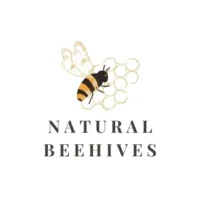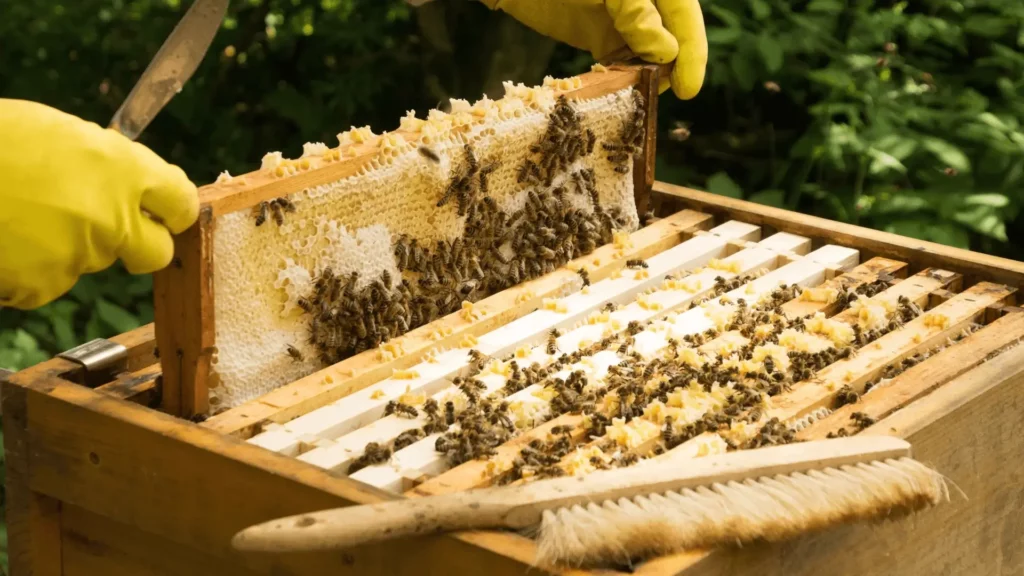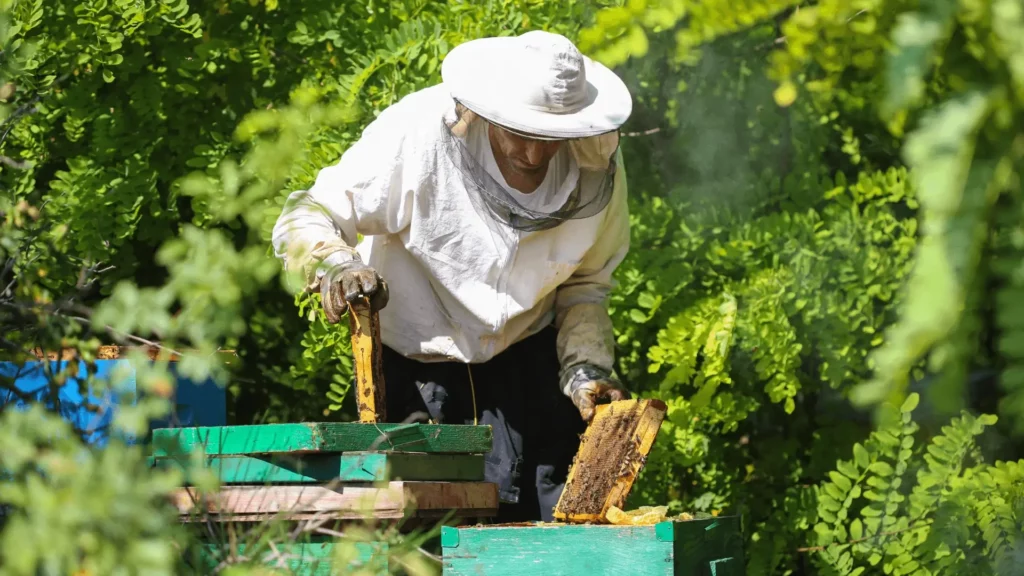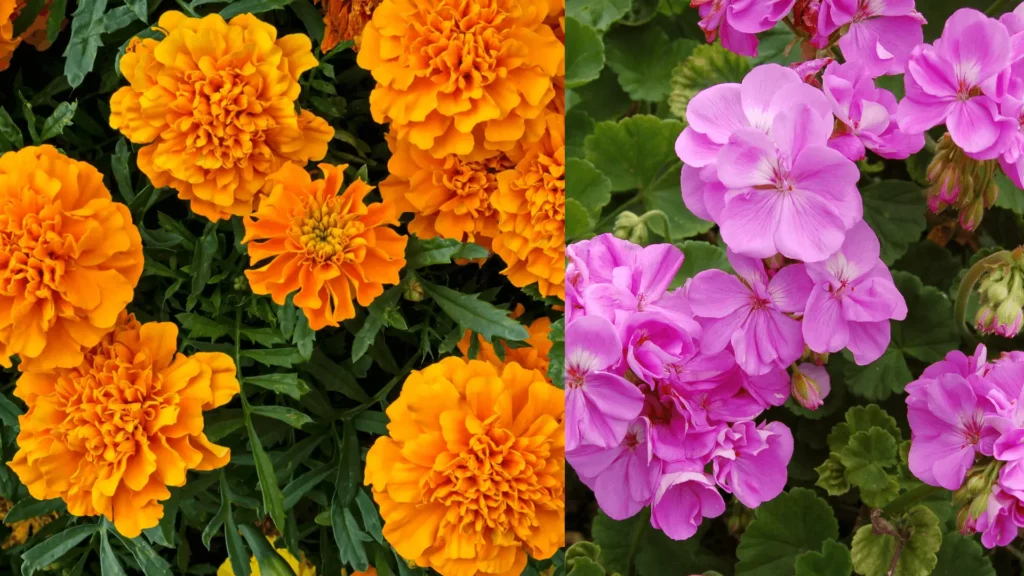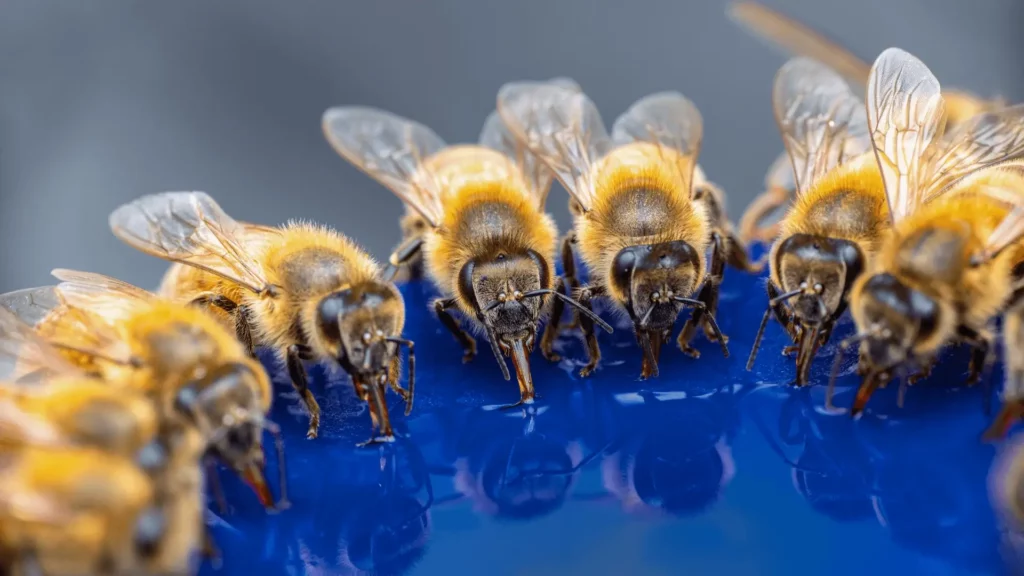
Imagine a world without bees. No vibrant blooms in gardens, no succulent fruits on trees, and no buzzing symphony in the air. Bees play a vital role in our ecosystem as pollinators, ensuring the survival and proliferation of countless plant species. But where do bees actually live, and how can we support them in their habitats?
In this article, we’ll dive into the enchanting world of bee habitats. We’ll explore the nesting habits of different bee species, from the European honeybee to solitary bees, and uncover the most important elements for their health and well-being. We’ll also discuss the use of man-made structures like bee houses and the significance of native plants in providing a good food source for these incredible creatures.
But it doesn’t stop there. We’ll also share practical measures that you can take to create bee-friendly environments in your own backyard or company site. From designing gardens that offer plenty of flowers to preserving open spaces and providing valuable sources of pollen and nectar, we’ll guide you on how to make a difference.
Keep reading as we highlight the crucial role of habitats in promoting bee health and conservation.
The Importance of Bee Habitats
Bees are not just industrious pollinators; they are integral to the health and balance of ecosystems worldwide. As we marvel at their intricate dance among flowers, it’s crucial to recognize the vital role that habitats play in supporting bee populations.
Bee habitats provide nesting spaces, forage sources, and protection for these buzzing creatures. Every aspect of their life cycle, from reproduction to foraging, relies on the presence of suitable habitats. Without them, bees face challenges in finding food, establishing colonies, and surviving in the face of environmental pressures.
But it’s not just bees that benefit from thriving habitats. Ecosystem health is intricately linked to the presence of bees and other pollinators. By facilitating the cross-pollination of plants, they ensure the reproduction and diversity of flora, which in turn provides food and habitat for countless other species. In fact, it is estimated that one out of every three bites of food we consume relies on pollinators like bees.
For these reasons, the preservation and restoration of bee habitats are of critical importance. By supporting and nurturing these essential environments, we can contribute to the well-being of not only bees but also entire ecosystems. In the following sections, we will explore the various nesting habitats of bees and learn practical ways to create bee-friendly environments that promote their survival.
Where Do Bees Live? Exploring Bee Nesting Habitats
Bees are fascinating creatures that rely on specific nesting habitats for their survival. These habitats vary depending on the species and can range from natural structures to man-made options. Let’s dive into the diverse nesting habitats of bees and discover the unique places they call home.
Natural Structures:
1. Tree Trunks: Many bee species, such as carpenter bees, bumblebees, and mason bees, excavate nesting chambers within the soft wood of decaying tree trunks.
2. Ground Nests: Some bees, like mining bees and sweat bees, create their nests in underground burrows. These bees prefer loose soil, creating tunnels and individual cells for their offspring.
3. Aerial Crevices: Certain species, including cavity-nesting bees, utilize natural openings in trees, such as cracks or crevices, to construct their nests.
Man-Made Options:
1. Bee Houses: These structures mimic natural nesting spaces, offering tubes or holes for solitary bees to lay their eggs. Hang bee houses in gardens or orchards to provide suitable nesting sites.
2. Bee Hives: Managed honeybees usually reside in man-made hives. Beekeepers provide carefully designed hive boxes, frames, and wax foundation for the bees to construct their combs.
It’s important to note that honeybees, being social insects, live in large colonies within their hives. On the other hand, solitary bees, like mason bees and leafcutter bees, prefer to nest individually.
Creating and preserving these nesting habitats is vital for the health and survival of bee populations. By incorporating a combination of natural structures and man-made options, we can encourage the presence of bees in our surroundings.
Remember, providing diverse and suitable nesting habitats for bees promotes their well-being and contributes to the overall health of our ecosystems. Let’s explore further how we can create bee-friendly gardens to support these incredible pollinators.
Creating Bee-Friendly Gardens
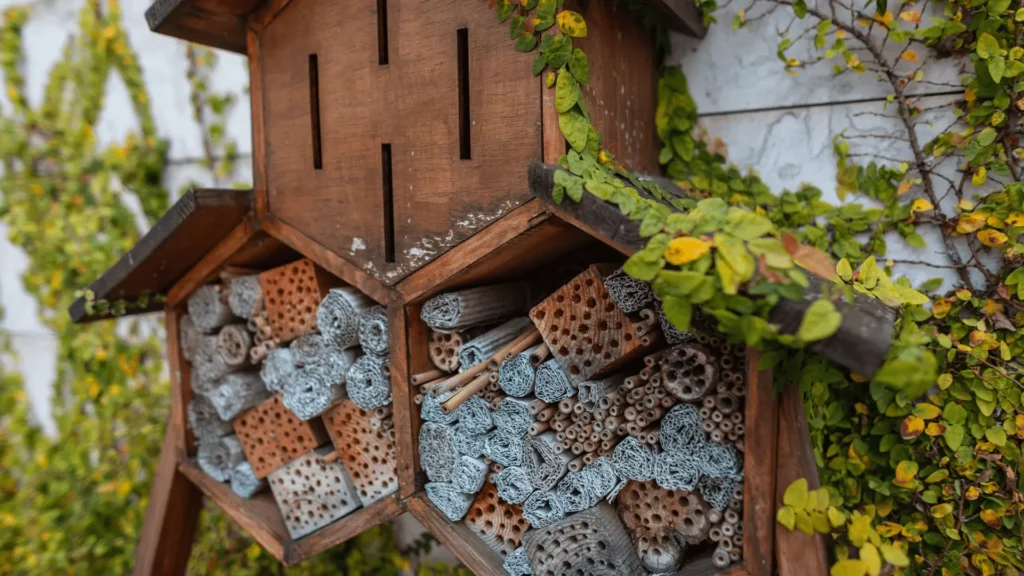
To create bee-friendly gardens that attract and support bee populations, it is important to focus on native plants and provide suitable habitats. Here are some tips and recommendations to help you design a garden that promotes bee health:
1. Choose Native Plants: Opt for native plant species as they offer a familiar and valuable source of food for bees. Native plants have co-evolved with local bee species, providing the nectar and pollen they need for sustenance.
2. Provide Continuous Bloom: Select a variety of plants that bloom at different times throughout the growing season. This ensures a steady supply of nectar and pollen for bees, supporting their nutritional needs.
3. Include a Variety of Flower Shapes and Colors: Bees are attracted to a diverse range of flower shapes and colors. Incorporate tubular flowers, flat-topped clusters, and composite flower heads to attract a wide range of bee species.
4. Avoid Pesticides: It is crucial to minimize or eliminate pesticide use in your garden. Pesticides can harm bees and other pollinators, compromising their health and survival. Instead, opt for organic and natural pest control methods.
5. Create Nesting Sites: Provide nesting opportunities for bees by incorporating features such as bee houses, bee blocks, or undisturbed areas of loose soil. These allow solitary bees to lay their eggs and enhance population diversity.
6. Provide a Water Source: Place a shallow water dish with rocks or floating objects in your garden. Bees need water for hydration, especially during hot and dry periods.
7. Minimize Disturbance: Avoid excessive garden maintenance and disturbance, particularly in areas where bees are nesting. Allow natural habitats to thrive and provide safe havens for bee populations.
By following these tips and integrating bee-friendly practices in your garden, you can contribute to the conservation and well-being of bees. Creating suitable environments with native plants and nesting sites will attract and support these vital pollinators, positively impacting the overall ecosystem. Remember, every garden can make a difference in preserving bee habitats.
Habitat Preservation for Bee Health
Preserving natural habitats and avoiding habitat degradation is of utmost importance for the well-being and survival of bee populations. Bees rely on their surrounding environments for food, nesting, and overall sustainability. Here are key reasons why habitat preservation plays a crucial role in bee health:
1. Biodiversity: Preserving natural habitats supports a diverse range of plant species, providing a consistent and nutritious food source for bees. This ensures they have access to a varied diet, essential for their optimal health and survival.
2. Nesting Sites: Undisturbed habitats, such as meadows, woodlands, and fields, offer suitable nesting sites for different species of bees. These sites provide the necessary conditions, such as loose soil, tree trunks, or aerial crevices, that bees need to build their nests and rear their young.
3. Pesticide Avoidance: Habitat preservation helps minimize exposure to harmful pesticides. By preserving natural areas, we reduce the reliance on chemical-intensive agricultural practices that can have detrimental effects on bees and other pollinators.
4. Ecosystem Support: Bees play a critical role in pollination, supporting healthy ecosystems. By preserving their habitats, we ensure the sustainability of these ecosystems and maintain the balance between plants and animals.
5. Conservation: Conserving natural habitats safeguards the long-term survival of bee species, many of which face threats from habitat loss and degradation. By protecting their habitats, we contribute to the conservation of these vital pollinators.
It is our responsibility to take action and protect the habitats that support bee populations. Through habitat preservation, we can promote healthy bee populations, secure pollination services, and contribute to the overall health of our environment.
Enhancing Bee Well-being with Man-Made Structures
In urban and suburban environments, man-made structures play a vital role in providing nesting opportunities for bees. Bee houses and bee hives are ingenious solutions that offer convenient nesting sites for these important pollinators. With their design and features, these structures mimic the natural nesting locations bees would typically seek out in the wild. They provide safe and secure spaces for bees to lay their eggs, raise their young, and store food. By incorporating man-made structures like bee houses and bee hives in our surroundings, we can create welcoming habitats for bees, contributing to their overall well-being and population growth.
Understanding and Supporting Foraging Behavior
Bee foraging behavior plays a vital role in the overall health and vitality of bee populations. Bees are diligent pollinators, and their foraging activities contribute to the pollination of crops and the maintenance of ecological balance.
To sustain healthy bee populations, it is essential to provide abundant and diverse food sources for bees. Bees rely on nectar and pollen as their primary sources of nutrition. Nectar serves as an energy-rich carbohydrate fuel, while pollen provides essential proteins and fats.
In their quest for food, bees exhibit remarkable navigation and communication skills. They use intricate dance patterns and pheromones to guide their fellow hive mates to fruitful foraging locations. Bees are attracted to a wide variety of flowers, with different bee species often displaying preferences for specific types of nectar and pollen sources.
Maintaining a range of flowering plants with varying bloom times throughout the growing season can help ensure a consistent and nutritious food supply for bees. By offering a diverse selection of plants, gardeners, and farmers can support a healthy and thriving bee population.
Cultivating Bee-Friendly Agriculture
Agricultural landscapes play a critical role in supporting bee populations and ensuring their health. By implementing bee-friendly measures, farmers can create habitats that provide ample food sources and nesting opportunities for bees. Here are some practical ways to support bees in agricultural environments:
1. Planting cover crops: Integrate cover crops into agricultural fields during fallow periods. These crops help provide a continuous supply of blooming flowers throughout the year, offering bees a valuable source of nectar and pollen.
2. Reducing pesticide use: Minimize the application of pesticides, especially those known to be harmful to bees. Opt for alternative pest control methods, such as integrated pest management, which target pests while minimizing harm to beneficial insects like bees.
3. Maintaining diverse forage sources: Maintain a diverse range of flowering plants, both within and outside the main crop areas. This ensures a variety of pollen and nectar sources for bees, improving their overall health and nutrition.
4. Creating habitat corridors: Set aside areas within agricultural landscapes to establish habitat corridors with native plants. These natural areas serve as refuges for bees and other pollinators, providing additional nesting sites and foraging opportunities.
5. Providing water sources: Ensure there are accessible water sources for bees in agricultural settings. Shallow dishes or water features with perches can provide bees with a much-needed hydration spot during hot and dry periods.
By adopting these bee-friendly practices, farmers can support bee populations and enhance pollination services in agricultural landscapes. Creating a healthy and sustainable environment for bees not only benefits crop productivity but also contributes to the overall conservation of these essential pollinators.
Also read: Natural Beekeeping: Embracing Sustainable Practices
The Vital Contribution of Native Plants to Bee Habitats
Native plants play a crucial role in providing suitable habitats and abundant food sources for native bee species. These plants have evolved alongside the local bee populations, ensuring a mutually beneficial relationship that supports the health and survival of both.
Why Native Plants Matter
– Native plants have adapted to the specific climate, soil conditions, and insect pollinators of their region. This makes them an excellent source of nectar and pollen for local bee species.
– The diverse range of native plants ensures a continuous supply of food throughout the blooming seasons, supporting bees’ nutritional needs.
– Native plants attract a variety of pollinators, enhancing the biodiversity and ecological balance of the ecosystem.
Benefits of Native Plants to Bees
– Native plant species offer a greater abundance and diversity of floral resources compared to non-native plants. This variety is essential for bees with different tongue lengths and foraging preferences.
– The structure of native plant flowers often provides easy access to nectar and pollen, making it more accessible for bees with varying sizes and physical characteristics.
– Native plants have co-evolved with local bees, developing a strong mutualistic relationship where bees efficiently pollinate the plants, ensuring successful reproduction for both parties.
How to Incorporate Native Plants
– Research native plant species in your region and select those that are appropriate for your site’s soil, light, and moisture conditions.
– Choose a variety of plants that offer bloom periods spanning the entire growing season to provide a continuous food source for bees.
– Create diverse habitats within your landscape, including areas with trees, shrubs, meadows, and wildflower patches to cater to the nesting and foraging requirements of different bee species.
By incorporating native plants into our landscapes, we can contribute to the conservation of our precious pollinators and support the health and diversity of bee habitats. Remember, every garden can make a difference.
Also read: Discover the Benefits of Beekeeping
Winding Up
To foster bee-friendly environments, it is crucial to create and preserve habitats that support bee populations. By following the tips and recommendations discussed throughout this article, you can make a meaningful impact on bee conservation efforts. Here are the key takeaways:
1. Design bee-friendly gardens: Incorporate native plants, which provide suitable habitats and abundant food sources for bees.
2. Preserve natural habitats: Avoid habitat degradation and promote the preservation of natural bee habitats to ensure their well-being.
3. Utilize man-made structures: Consider the use of bee houses and hives, particularly in urban areas, to provide nesting opportunities for bees.
4. Understand bee foraging behavior: Maintaining diverse and abundant food sources is essential for sustaining healthy bee populations.
5. Implement bee-friendly practices in agriculture: Plant cover crops, reduce pesticide use, and create open spaces to support bees in agricultural landscapes.
By taking these practical measures, you can contribute to the protection and enhancement of bee habitats, ensuring the continued health and survival of these crucial pollinators. Remember, every effort, no matter how small, is valuable in supporting bee populations and maintaining the ecological balance they provide.
